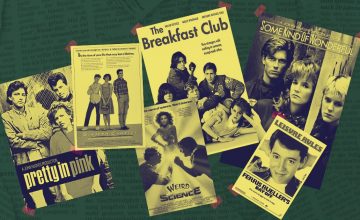If you’re chronically online, you’ve probably come across unsolicited takes on bubblegum P-pop—or just pop, in general. I’ve personally seen opinions like “I don’t vibe with *insert artist’s name* because their music sounds so childish” or “This bubblegum pop shit should’ve just stayed in the drafts.” But what exactly is bubblegum pop and what’s with the aversion toward it?
Think “Gee” by SNSD, “TT” by Twice, and “ME!” by Taylor Swift. It’s a subgenre of pop music that usually sounds playful and sweet with innocent, youthful lyrics. Most people tend to associate it with teen girls, which is probably why it’s often labeled as cringey and immature. Or in our local jargon: pabebe.
Bubblegum pop in the local scene
Bubblegum P-pop got some mainstream attention around 2014, when the soundtrack album for the blockbuster JaDine movie “Diary ng Panget” was released. It included Nadine Lustre’s hit single “Paligoy-ligoy”—a song that sparked a rather interesting debate among listeners.
During that time, K-pop was growing a solid following in the Philippines. Girl crush concepts—which project the image of a confident and empowered woman—were (and still are) admired by fans and non-fans alike. In 2011, “The Boys” by SNSD and “I Am the Best” by 2NE1 entered local music charts. I myself knew all the words to “I Am the Best” and sang along to it at any given chance. Both songs were giving bad bitch energy, which admittedly were—are—a breath of fresh air in an otherwise sexist music industry.
And this perhaps was one of the reasons a lot of people didn’t take Lustre’s song seriously. Sure, it was received well commercially, but it also got a lot of criticism from the public for its overall concept. I even remember seeing tweets like, “Women are empowered people. ‘Pambata’ concepts like this ain’t it.”
Here’s how prejudice against bubblegum pop manifested: even after Melchora Mabilog’s “Mahal Kita Pero” (performed by Janella Salvador) won 3rd Best Song at the 2014 Himig Handog P-Pop Love Songs, it still didn’t get a fair shot in the mainstream.
While girl crush and badass concepts continued to rule the local music scene beyond 2014 (Blackpink’s insane popularity is proof enough), bubblegum pop was pushed into a corner where no one paid it any mind. Or at least that’s how it felt when mainstream Filipino artists started releasing songs in every genre possible except bubblegum pop. “Hugot” songs like “Mahal Ko o Mahal Ako” by KZ Tandingan, “Malaya” by Moira dela Torre, and “Maybe the Night” by Ben&Ben dominated FM radio and have become household favorites.
It is worth mentioning MNL48 and their efforts into the genre. It’s a 48-member all-female idol group, which I personally think had so much potential to reintroduce bubblegum pop in the country—especially with a release like “Pag-ibig Fortune Cookie.” But considering the majority of their discography was just direct translations of Japanese idol group AKB48’s existing songs, people had a hard time resonating with their music.
BINI’s attempt to resurrect a dying genre
There are two ways bubblegum pop can penetrate the local music industry again: one, an established singer decides to switch up their style and venture into bubblegum pop (which is rather unlikely), or two, a new generation of artists takes the leap and experiments with the genre.
Fortunately, BINI—a P-pop group composed of eight “young, modern Filipinas”—has seemingly set their eyes on reviving bubblegum pop. Prior to debuting, the group released a rearranged and modernized version of Smokey Mountain’s novelty hit “Da Coconut Nut.” (Fun fact: National artist Ryan Cayabyab had a hand in its production.)
BINI then debuted with an electronic pop track entitled “Born to Win” that showcased their powerful vocals and sharp dance lines—an entirely different image from their pre-release project. Given this impression, one would think they’re also adopting a girl crush concept, but interestingly, their succeeding releases have all been bubblegum pop-influenced.
Their latest singles “Na Na Na” and “Lagi” are currently making waves on different platforms, with the latter even debuting number one on the local iTunes chart. As of writing, more than 360,000 videos have used these songs on TikTok. The general public is receiving them well—with some people even saying it’s “how P-pop originally sounds like.”
If BINI continues to drop songs that put bubblegum pop in a different light, it would only be a matter of time until more P-pop acts experiment with the genre. But at present, we still have to deal with a lot of people who see it as “cringey” and “pambata.”
The problem with labeling bubblegum pop as “pambata”
People love seeing “alpha” females establish dominance and sing about not needing love, or men in particular—and bubblegum pop is the exact opposite of that. It anchors itself in the idea of being young and in love, chasing after the person of your dreams. But because of the themes—and who is likely to consume it, a.k.a. teen girls—it tends to be dismissed as music not being worth taking seriously.
What everyone doesn’t seem to get, though, is that people who sing about falling in love can just be as strong and empowered as those who sing about being independent.
What everyone doesn’t seem to get, though, is that people who sing about falling in love can just be as strong and empowered as those who sing about being independent. Love and independence can coexist. Heck, even the most empowered people sometimes crave the feeling of being in love, you know? It wouldn’t make them any less of a person to want that.
Pigeonholing the genre as “pambata” also implies that people who are into it are immature or incapable of enjoying something more “substantial.” Teen-dominated fandoms tend to be derided by “mature” music lovers, thinking their tastes haven’t developed yet and so whatever they like is automatically not good.
Teen-dominated fandoms tend to be derided by “mature” music lovers, thinking their tastes haven’t developed yet and so whatever they like is automatically not good.
But this is nothing but a poor assumption—an unfair generalization. Case in point: Directioners, a fandom largely composed of teens, launched “Project: No Control” in 2014 to let One Direction (1D) know that they wanted to see maturity and growth in the band’s discography.
Fans thought “No Control,” a b-side track in 1D’s album “Four,” deserved more attention than the actual singles “Steal My Girl” and “Night Changes”—both having the formulaic “boy band” sound. Directioners promoted “No Control” on their own, and as a result, the song gained more than one million U.S. streams in a week and scored a No. 1 on the Billboard Hot 100.
Bubblegum pop as a comfort genre
The world is already cruel as it is. Your heart can easily be torn to shreds by broken trust and relationships, happiness zinged away at the speed of light. So what’s so bad about temporarily escaping harsh realities by singing about the euphoria young love brings?
Admit it or not, there will be times when you want to go back to being innocent and free from worries—a concept that bubblegum pop embodies.
Admit it or not, there will be times when you want to go back to being innocent and free from worries—a concept that bubblegum pop embodies. It’s straightforward, a genre that celebrates naivety. You don’t need to come up with elaborate theories to decode the song’s message as fans have to do with many K-pop releases these days. Some song and group concepts even involve artificial intelligence and cinematic universes. (Ahem, Kwangya.)
Bubblegum pop also balances out the heavier themes the local music scene veers toward. Understandably, there are more political songs now given the state of the world (just ask Gen Zs). But there’s no denying it: It feels refreshing to listen to something that makes you feel 13 again.
It reminds you of simpler times and allows you to reminisce about all the warm moments from your younger years. It takes you back to those days when you would go gaga over your happy crush, feeling giddy whenever they greeted you in passing. And maybe it can show you that even in your older age, those moments aren’t past you just yet.
With its lighthearted and optimistic nature, bubblegum pop provides a safe space for everyone regardless of their age or background.
With its lighthearted and optimistic nature, bubblegum pop provides a safe space for everyone regardless of their age or background. So once and for all, can we stop the notion that bubblegum pop is inferior to other genres just because it deals with youthful themes (and also tends to be really catchy)?
We’re looking forward to an era when people can listen to bubblegum pop without judgment, and can sincerely appreciate it for being uplifting and fun. Hopefully, more P-pop acts explore the genre—and we really think it’s coming soon. All thanks to artists like BINI.
Read more:
For P-pop artists, fans hold the future of the genre
Kaia, the next P-pop group you’ll stan, has dropped their first single
SB19 makes P-pop history in Billboard’s year-end chart
Art by Yel Sayo
Photo from @starmusicph on Instagram
























Comments